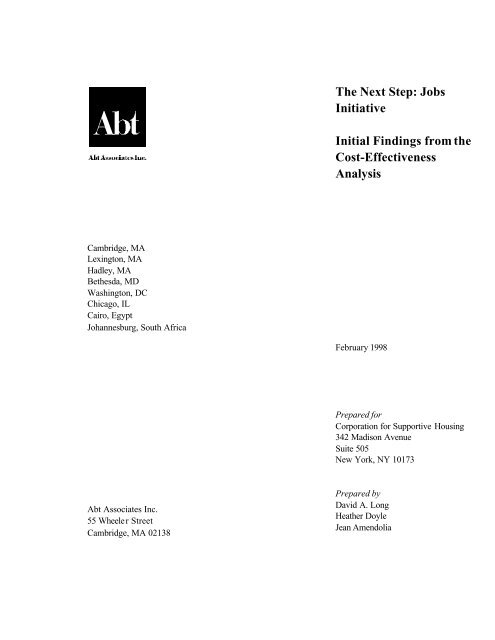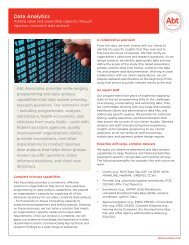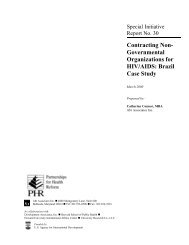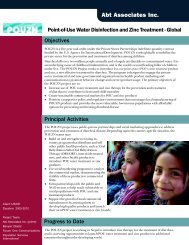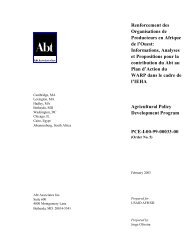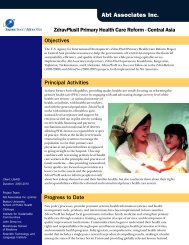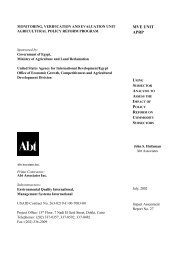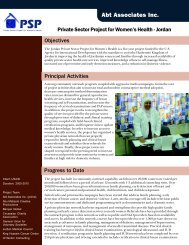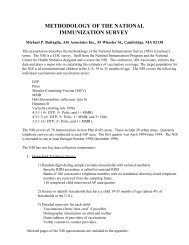The Next Step: Jobs Initiative Initial Findings from ... - Abt Associates
The Next Step: Jobs Initiative Initial Findings from ... - Abt Associates
The Next Step: Jobs Initiative Initial Findings from ... - Abt Associates
Create successful ePaper yourself
Turn your PDF publications into a flip-book with our unique Google optimized e-Paper software.
<strong>The</strong> <strong>Next</strong> <strong>Step</strong>: <strong>Jobs</strong><br />
<strong>Initiative</strong><br />
<strong>Initial</strong> <strong>Findings</strong> <strong>from</strong> the<br />
Cost-Effectiveness<br />
Analysis<br />
Cambridge, MA<br />
Lexington, MA<br />
Hadley, MA<br />
Bethesda, MD<br />
Washington, DC<br />
Chicago, IL<br />
Cairo, Egypt<br />
Johannesburg, South Africa<br />
February 1998<br />
Prepared for<br />
Corporation for Supportive Housing<br />
342 Madison Avenue<br />
Suite 505<br />
New York, NY 10173<br />
<strong>Abt</strong> <strong>Associates</strong> Inc.<br />
55 Wheeler Street<br />
Cambridge, MA 02138<br />
Prepared by<br />
David A. Long<br />
Heather Doyle<br />
Jean Amendolia
TABLE OF CONTENT<br />
<strong>Initial</strong> <strong>Findings</strong> <strong>from</strong> the Cost-Effectiveness Analysis of the <strong>Next</strong> <strong>Step</strong>: <strong>Jobs</strong> <strong>Initiative</strong> ...........1<br />
1. Employment Services at Three Sites ............................................2<br />
1.1 Thresholds .........................................................3<br />
1.2 Lakefront ..........................................................4<br />
1.3 Jericho ............................................................5<br />
2. Approach to the Cost-Effectiveness Analysis .....................................6<br />
2.1 Estimating the Cost of <strong>Next</strong> <strong>Step</strong>: <strong>Jobs</strong> ...................................7<br />
2.2 Assessing the Determinants of Costs ......................................9<br />
2.3 Weighing Costs and Benefits ...........................................11<br />
3. Preliminary Results ........................................................15<br />
3.1 Program Function Costs ..............................................15<br />
3.2 Participation Rates ..................................................17<br />
3.3 Total Costs per Sample Member ........................................19<br />
Appendix A .................................................................22<br />
Appendix B .................................................................24
<strong>Initial</strong> <strong>Findings</strong> <strong>from</strong> the Cost-Effectiveness<br />
Analysis of the <strong>Next</strong> <strong>Step</strong>: <strong>Jobs</strong> <strong>Initiative</strong><br />
<strong>The</strong> <strong>Next</strong> <strong>Step</strong>: <strong>Jobs</strong> initiative is intended to increase employment and earnings among<br />
residents of supportive housing, who have been homeless or at risk of homelessness and often have<br />
been chronically unemployed. <strong>The</strong> initiative, which is operated by the Corporation for Supportive<br />
Housing (CSH) and supported by <strong>The</strong> Rockefeller Foundation, began operations in July 1995.<br />
Employment services are provided at 17 supportive housing sites in Chicago, New York, and the San<br />
Francisco Bay Area. <strong>The</strong> evaluation of <strong>Next</strong> <strong>Step</strong>: <strong>Jobs</strong> involves three efforts: a Tenant Management<br />
Information System (MIS) developed by the Vanderbilt Institute for Public Policy Studies (VIPPS),<br />
an ethnographic study carried out by the Nathan Kline Institute, and a cost-effectiveness analysis<br />
conducted by <strong>Abt</strong> <strong>Associates</strong>.<br />
This is the first of two reports on the cost-effectiveness analysis. It presents our initial<br />
findings on the cost of providing employment services and summarizes our plan for assessing the<br />
services’ cost-effectiveness. <strong>The</strong> results identify the costs of including employment services in the<br />
supported housing programs at three of the nine sites where the cost-effectiveness analysis is being<br />
conducted. Two of these three sites are in Chicago and one is in New York City. <strong>The</strong> analysis<br />
completed to date has yielded these results:<br />
• <strong>The</strong> cost of employment services during the first nine months that were provided to<br />
residents at the three supportive housing sites ranges <strong>from</strong> $806 to $3,958 per<br />
resident. <strong>The</strong>se estimates include the cost of services provided by outside agencies,<br />
to which residents have been referred by program staff, as well as the cost of services<br />
provided by the sites themselves.<br />
• Half of the cost of the employment services is attributable to two important program<br />
functions at the <strong>Next</strong> <strong>Step</strong>: <strong>Jobs</strong> sites. One is job development and placement, which<br />
includes activities such as job search assistance, on-site job creation, job coaching,<br />
development of employment and training relationships with employers, and referrals<br />
to positions in the regular labor market. <strong>The</strong> other is in-house employment, which<br />
includes on-site internships and sheltered workshops as well as employment with the<br />
sponsoring agency and any businesses it operates.<br />
1
• Differences in cost estimates across the three sites reflect noteworthy differences in<br />
the program approaches and participation rates across the three sites. <strong>The</strong>se<br />
differences in approach and participation are themselves partly due to differences in<br />
the populations served by these sites.<br />
It is important to recognize that these are preliminary results, covering only the first nine months that<br />
residents received employment services at only three sites.<br />
<strong>The</strong> final report, which is scheduled to be completed later this year, will present final estimates<br />
of the costs at these three sites—covering 21 months <strong>from</strong> the time residents first received<br />
employment services—as well as cost estimates for the other six sites. It will also provide a more<br />
thorough analysis of the costs of employment services in supportive housing settings, covering all nine<br />
sites and systematically identifying the most important determinants of these costs. Finally, the costs<br />
of the employment services will be compared to the value of their effects on supportive housing<br />
residents’ employment, receipt of public assistance and services, and other outcomes.<br />
<strong>The</strong> results of the cost-effectiveness analysis are intended to provide practical feedback to the<br />
community agencies that are implementing the <strong>Next</strong> <strong>Step</strong>: <strong>Jobs</strong> initiative; help potential government<br />
and philanthropic funders make more informed choices in considering similar policy initiatives; and<br />
furnish useful findings to other decision makers, practitioners, and analysts who are interested in<br />
policy approaches like this one. This information should be particularly valuable given the very<br />
limited prior experience implementing and evaluating housing-based employment services for<br />
supportive housing residents.<br />
1. Employment Services at Three Sites<br />
All nine sites to be covered by the cost-effectiveness analysis, which are listed in Table 1,<br />
share important characteristics. Each of these sites has integrated a range of employment services<br />
into its supportive housing program. All serve homeless or recently homeless populations facing<br />
multiple barriers to personal development and financial self-sufficiency. In addition, all are established<br />
urban community-based organizations with strong linkages to other agencies in their communities.<br />
2
Table 1<br />
Sites Involved in the Cost Analysis<br />
Supportive Housing Program<br />
Lakefront SRO, Inc.: Delmar Building<br />
Thresholds: Austin Apartments<br />
Jericho Project: Harlem Program<br />
Community Access, Inc.: Avenue D<br />
Project Renewal: Holland Hotel<br />
Center for Urban Community Services: BHDF<br />
Common Ground: Times Square Hotel<br />
Episcopal Community Services: Canon Kip<br />
Rubicon Program<br />
Location<br />
Chicago<br />
Chicago<br />
New York City<br />
New York City<br />
New York City<br />
New York City<br />
New York City<br />
San Francisco<br />
Richmond<br />
However, the sites are far <strong>from</strong> being homogeneous. <strong>The</strong>y serve different populations, use<br />
different program models, and have different scales of operation. <strong>The</strong>y also rely to different degrees<br />
on in-house services as opposed to referring residents to services <strong>from</strong> other agencies. <strong>The</strong> three sites<br />
covered in this initial assessment, which are highlighted in the table and discussed below, illustrate<br />
these differences.<br />
1.1 Thresholds<br />
<strong>The</strong> employment services program for Austin Apartments, operated in Chicago by Thresholds,<br />
is directed to individuals with serious mental health problems. Thresholds is a large<br />
3
organization—with more than 700 employees and dozens of program locations throughout the<br />
Chicago metropolitan area—and has been in operation for more than 40 years. Since its inception the<br />
organization has provided employment services to the people it serves. It has more recently become<br />
a supportive housing provider as well. This experience differs <strong>from</strong> the other two sites, both of which<br />
added employment services to their core supportive housing programs.<br />
Over the years, Thresholds has developed an elaborate and integrated service delivery<br />
structure. Employment services are one element in a multi-faceted package that also includes<br />
extensive mental health services (including diagnosis, treatment, and rehabilitation), life skills training,<br />
counseling and support groups, and a wide range of support services. <strong>The</strong> primary sources of funding<br />
for the employment services are the grant <strong>from</strong> the Corporation for Supportive Housing for the<br />
<strong>Next</strong><strong>Step</strong>: <strong>Jobs</strong> initiative, and funding <strong>from</strong> two public agencies in Illinois, the Office of Rehabilitation<br />
Services and the Office of Mental Health.<br />
<strong>The</strong>re are four specific employment staff members at Thresholds who work with Austin<br />
Apartments residents: a Vocational Coordinator, who focuses on job development issues; a Pre-<br />
Vocational Coordinator; a job coach who visits work sites and conducts support activities; and a<br />
staffmember with varying responsibilities who has recently focused on on-site employment activities.<br />
In addition, case managers talk with residents about employment issues, though most residents are<br />
referred to members of the employment staff.<br />
A distinctive feature of this program is a group of small businesses operated as a separate<br />
entity called Thresholds Rehabilitation Industries (TRI). <strong>The</strong>se businesses include Lincoln Laser,<br />
wich reconditions cartridges for laser printers; TRI Construction; Turtzel, which makes chocolatecovered<br />
pretzels; and a cleaning service. <strong>The</strong> businesses produce revenues that, overall, fully cover<br />
the costs of their operation.<br />
1.2 Lakefront<br />
<strong>The</strong> Delmar building, one of a number of supportive housing programs operated by Lakefront<br />
SRO in Chicago, has the most residents of the three sites. <strong>The</strong> resident population is more diverse<br />
than the other two sites, including people with mental illness, substance abuse histories, and other<br />
4
problems. Lakefront offers a narrower range of in-house services than Thresholds, but refers<br />
residents to outside agencies as needed.<br />
Employment services are handled through a seven-person employment department at<br />
Lakefront. <strong>The</strong> department’s director oversees an employment manager (who supervises two job<br />
coaches), an employment coordinator (who develops job training partnerships with area employers),<br />
and a construction manager (who runs a construction workshop offering training and hands-on work<br />
experience in the construction trades). In addition to its grant <strong>from</strong> the Corporation for Supportive<br />
Housing, Lakefront funds the employment services provided by this department with financial support<br />
<strong>from</strong> the Illinois Department of Housing, the United Way, and the Illinois Department of Human<br />
Services.<br />
Residents of all Lakefront buildings (who currently number 685) have access to this<br />
department and the services it offers. However, Delmar residents have a stronger incentive to utilize<br />
the services, because they are required to pay a market rate rent for their rooms. Recruitment and<br />
intake of Delmar residents into Lakefront’s employment program is partly handled by the case<br />
managers at the Delmar building. For all employment services, however, Delmar residents visit the<br />
employment office.<br />
1.3 Jericho<br />
<strong>The</strong> Jericho Work Program in Harlem, the smallest program of the three sites covered in this<br />
report, operates in one of three supportive housing buildings run by the Jericho Project in New York<br />
City. Jericho’s services, including employment activities, are generally the same at all three buildings,<br />
but the demographics of the residents are quite different. Residents of the Harlem building, twothirds<br />
of whom were referred by the New York City Department of Homeless Services, all have had<br />
substance abuse problems. <strong>The</strong> number of residents with severe mental illness is low, but about a<br />
quarter of residents receive state Vocational Rehabilitation (VR) services for physical difficulties.<br />
Jericho provides a range of services and the utilization rate for these services is strikingly high.<br />
All residents receive extensive substance abuse counseling, because they are required both to be sober<br />
and to go to relapse prevention meetings and men’s/women’s groups. All residents use employment<br />
5
services as well. Regardless of their work experience, interests, or skills, all individuals are referred<br />
to the Vocational Education unit, assessed, and expected to participate in work activities. Jericho<br />
also offers education services (including classes and individual instruction in job readiness, job finding,<br />
and resume writing as well as life skills classes and referrals to basic skills training, GED programs,<br />
and area colleges), help with personal finances (there is a savings account system for residents) and<br />
transportation (staff give out tokens as needed), and after-care (when residents leave the Jericho<br />
program, they are provided help with their move and family reunification).<br />
Most employment services are provided by the Vocational Education unit, which has a<br />
director and three staff. <strong>The</strong> staff who provide residential services in the Harlem building counsel<br />
residents on employment issues and sometimes provide other employment services, as does the<br />
director of the After Care unit. <strong>The</strong> employment services are supported primarily by the grant <strong>from</strong><br />
the Corporation for Supportive Housing and funding <strong>from</strong> New York City agencies.<br />
2. Approach to the Cost-Effectiveness Analysis<br />
<strong>The</strong>re are three reasons for conducting this analysis. <strong>The</strong> first is to determine the full cost of<br />
the employment services by estimating the dollar value of all resources used in providing the services<br />
to residents of supportive housing in the programs that make up the <strong>Next</strong> <strong>Step</strong>: <strong>Jobs</strong> initiative. <strong>The</strong><br />
cost estimation methods to be used will put a price tag on the <strong>Next</strong> <strong>Step</strong>: <strong>Jobs</strong> model that is now in<br />
place at each site. This includes the full set of employment services these organizations now offer,<br />
including services funded by both CSH and other sources. <strong>The</strong> cost estimates will also include the<br />
cost of all relevant employment services provided by other organizations, but arranged by site<br />
program staff, in addition to the cost of the services that are actually delivered by the sites themselves.<br />
<strong>The</strong> second goal of the analysis is to assess the determinants of the employment service’s<br />
costs. <strong>The</strong> <strong>Next</strong> <strong>Step</strong>: <strong>Jobs</strong> initiative has several different components—such as recruitment and job<br />
development—and the costs of these components are likely to vary considerably across sites. Such<br />
cost variation probably has a number of causes, including differences in program scale, different<br />
locations and organizational settings, differences in the characteristics of supportive housing residents<br />
across sites, different ways of delivering services, and different staffing configurations. If cost<br />
6
variation is found to be strongly related to one or more of these factors, we could gain valuable<br />
information about the key determinants of the costs of employment services for supportive housing<br />
residents.<br />
<strong>The</strong> third reason for the analysis is to determine whether the benefits of the employment<br />
services outweigh their costs. Such an appraisal is always difficult to make for social programs, but<br />
it is particularly difficult in this case. This is partly due to the fact that many of the benefits and costs<br />
of the employment services to supportive housing residents cannot be measured. It also results <strong>from</strong><br />
the fact that, while many benefits and costs can be measured, the research on the <strong>Next</strong> <strong>Step</strong>: <strong>Jobs</strong><br />
initiative was not specifically designed to measure the employment services’ net effects. As discussed<br />
below, however, we have developed a credible plan for estimating these effects.<br />
2.1 Estimating the Cost of <strong>Next</strong> <strong>Step</strong>: <strong>Jobs</strong><br />
To estimate the full costs of the <strong>Next</strong> <strong>Step</strong>: <strong>Jobs</strong> initiative, we must first take into account all<br />
pertinent expenditures made by the sites, using funds <strong>from</strong> both CSH and other sources. We must<br />
also take into consideration expenditures made by outside organizations in providing employment<br />
services to <strong>Next</strong> <strong>Step</strong>: <strong>Jobs</strong> participants as a result of referrals and other arrangements made by site<br />
staff. For example, a site may provide no occupational skills training itself, even though such training<br />
is an essential part of its program model. Instead it may refer residents to outside agencies for<br />
training, and consequently incur no expenses itself. Another site may provide in-house training, but<br />
charge the costs of the training to a special grant it received rather than to its employment and<br />
training services budget. Both types of expenditures are nonetheless part of the total cost of<br />
implementing the <strong>Next</strong> <strong>Step</strong>: <strong>Jobs</strong> model, and clearly must be taken into account in the costeffectiveness<br />
analysis.<br />
Thus, this component of the cost-effectiveness the analysis will place a dollar value on the<br />
investment that sponsor agencies and other organizations make in delivering the employment services<br />
that are promoted in the <strong>Next</strong> <strong>Step</strong>: <strong>Jobs</strong> initiative. This investment excludes the cost of supportive<br />
housing itself, as well as the cost of all non-employment services. It is noteworthy, too, that this<br />
constitutes the gross rather than net investment in employment services made by the agencies. Many<br />
supportive housing residents would receive employment services, although probably not as many, in<br />
7
the absence of the <strong>Next</strong> <strong>Step</strong>: <strong>Jobs</strong> initiative. As a result, the net investment is the cost of <strong>Next</strong> <strong>Step</strong>:<br />
<strong>Jobs</strong> employment services over and above the cost of services that would be obtained by supportive<br />
housing residents had the initiative never operated. This net cost of the employment services will be<br />
addressed when the costs of <strong>Next</strong> <strong>Step</strong>: <strong>Jobs</strong> are compared to its benefits, as discussed below.<br />
<strong>The</strong> full costs of the <strong>Next</strong> <strong>Step</strong>: <strong>Jobs</strong> initiative will eventually be measured, on a per<br />
1<br />
participant basis, across all nine sites listed in Table 1. <strong>The</strong> cost estimates presented in the next<br />
section of this report, however, cover a limited time period at only three of these sites. Nevertheless,<br />
the approach used to develop these preliminary estimates is exactly the same as the approach that will<br />
be used to produce the final estimates. This approach—which is described briefly here and in more<br />
detail in Appendix A—involves three steps. <strong>The</strong> first is to determine the employment services that<br />
members of our sample have received. Data <strong>from</strong> the VIPPS management information system will<br />
2<br />
be used to do this for seven of the nine sites, including all three covered in this report. Information<br />
on the vast number of services covered by the MIS will, for the purposes of the cost-effectiveness<br />
analysis, be classified into eight program functions, as discussed below.<br />
Recruitment and intake cover the up-front activities that enable tenants to receive<br />
services—that is, the recruitment efforts, initial intake session, orientation, vocational assessments,<br />
and other contact between tenants and staff before services are actually provided. Pre-vocational<br />
activities refer to activities—such as basic skills and GED classes, life skills training, job readiness<br />
activities, English-as-a-second-language classes, and pre-employment support groups—that are<br />
intended to prepare tenants for employment or training. Job development, referral, and placement<br />
include other activities ! namely job development efforts, job referrals and placements, assistance<br />
with job search and interviews, job coaching, day job referral, group training placements, internal<br />
placements, and job creation ! that occur before tenants start employment or training.<br />
<strong>The</strong> remaining program functions occur after employment or training has started. On-site<br />
employment refers to all in-house employment, including internships and sheltered workshops, as well<br />
1 “<strong>Next</strong> <strong>Step</strong>: <strong>Jobs</strong>” refers to all employment services provided or arranged by the sites, whether or not they are<br />
funded by CSH. “Participant” refers to a supportive housing resident who receives at least one employment<br />
service; it does not refer to residents who receive other services or participate in other housing-based activities.<br />
2 At the other two sites, Times Square and Rubicon, <strong>Abt</strong> <strong>Associates</strong> is collecting comparable information especially<br />
for the cost-effectiveness analysis.<br />
8
as to all related activities (such as paying stipends or wages). On-site training refers to all in-house<br />
training, including both classroom and on-the-job training. Off-site employment and training includes<br />
all involvement with outside employment and training, including temporary and part-time jobs and<br />
all types of employment and training programs. Finally, job and training retention activities refer to<br />
all support activities for participants in employment and training, as well as to services specifically<br />
intended to help them perform well in on-site and off-site positions. It also includes arranging support<br />
services, such as transportation to suburban jobs, specifically needed by participants who are<br />
employed or in training.<br />
<strong>The</strong> second step is to determine the cost of each function per participant—that is, the cost of<br />
serving one person in the activities included in the function for the nine months covered by this<br />
preliminary analysis. For each function, the numerator of the estimated cost is a share of the sites<br />
total expenditures over the nine months, based on an analysis of labor and other costs during that<br />
period. <strong>The</strong> denominator is the number of people, including individuals in our sample as well as<br />
others who are not, who participated in pertinent activities during the period.<br />
<strong>The</strong> third step is to calculate the total cost of the services per participant. For each function,<br />
this cost is the product of two figures: the participation rate (determined in step 1) and the unit cost<br />
estimate (determined in step 2). For each site, the costs per participant of seven functional<br />
components of the employment services will be calculated. <strong>The</strong> sum of these seven component costs<br />
represents the total cost of employment services per participant.<br />
2.2 Assessing the Determinants of Costs<br />
It is expected that the cost estimation effort will produce a wide range of cost estimates across<br />
the nine sites, indicating that the cost of providing employment services to supportive housing<br />
residents can vary considerably. <strong>The</strong> second objective of the cost analysis is to explain this variation<br />
in site costs.<br />
<strong>The</strong> aggregate costs of <strong>Next</strong> <strong>Step</strong>: <strong>Jobs</strong> are, in large part, a function of the number of<br />
participants who receive employment services. By focusing on the cost per participant, an assessment<br />
can be made of the determinants of costs other than the volume of participant enrollment. In trying<br />
to identify the determinants of cost per participant, attention will be focused on cost variation across<br />
9
sites. When cost information is available on all nine sites, the principal mode of inquiry will be<br />
regression analysis, which will determine which of many factors are primarily responsible for the<br />
variation. Other types of analysis, making use of several types of tabulations of expenditures, will<br />
also be used. However, the preliminary assessment of cost variation provided later in this report is<br />
based on less systematic comparisons of the data obtained thus far <strong>from</strong> only three sites.<br />
<strong>The</strong> regression analysis that will eventually be undertaken is expected to be straightforward.<br />
<strong>The</strong> dependent variable in the analysis will be a measure of cost per participant—either the overall<br />
cost per participant or the cost of a specific program component per participant. A variety of<br />
independent variables will be used. Potential explanatory variables will be identified during the cost<br />
data collection effort as well as <strong>from</strong> the findings of other aspects of the <strong>Next</strong> <strong>Step</strong>: <strong>Jobs</strong> evaluation,<br />
notably the implementation analysis. For example, these variables might include program scale (total<br />
enrollment across all employment activities), housing scale (total number of supportive housing<br />
residents served by the sponsor agency), program implementation stage (whether the site’s<br />
accounting period includes early start-up months of operations), organizational setting (mental health<br />
organization, housing developer, etc.), location (Chicago, New York, San Francisco), population<br />
served (mentally ill, homeless women, HIV patients, substance abusers, etc.), and sources of funding<br />
other than CSH grants.<br />
Some relationships are to be expected. For example, most administrative overhead costs per<br />
participant should be reduced by large program scale. Others, such as whether costs are higher in<br />
certain types of organizations, are less certain. However, it should be emphasized that this analysis<br />
will be exploratory in nature, both because of the limited number of sites being studied and because<br />
the initiative is one of the first of its kind.<br />
2.3 Weighing Costs and Benefits<br />
<strong>The</strong> cost analysis addresses the question: What is the cost of including employment services<br />
in supportive housing prpograms <strong>The</strong> cost-effectiveness analysis will address a related and critically<br />
important question: Do the effects of the employment services justify its cost In other words, what<br />
are the benefits of the services, and how does the value of these benefits compare to the cost of the<br />
services<br />
10
Rigorous analytical methods for assessing a social program’s benefits and costs are well<br />
established. However, these methods presume that the net impacts of the program can be measured<br />
using a formal experimental or quasi-experimental research design. <strong>The</strong> evaluation of <strong>Next</strong> <strong>Step</strong>: <strong>Jobs</strong><br />
does not include such an effort. Thus, the primary issue for the cost-effectiveness analysis is how to<br />
estimate the effects of the initiative so they can be compared to its costs. We have consequently<br />
sought to identify a sample of eligible individuals who are not participating in a <strong>Next</strong> <strong>Step</strong>: <strong>Jobs</strong><br />
program, but whose behavior is the same as what participants’ behavior would have been in the<br />
absence of the initiative. For this sample we would need to obtain a set of longitudinal data on<br />
earnings, public assistance receipt, and other pertinent outcomes that is comparable to the information<br />
that VIPPS is assembling on participants in the eight <strong>Next</strong> <strong>Step</strong>: <strong>Jobs</strong> sites where MIS data are being<br />
collected.<br />
<strong>The</strong> search for a comparison group “most like” actual <strong>Next</strong> <strong>Step</strong>: <strong>Jobs</strong> participants, and for<br />
a specific sample for which data comparable to the MIS are available, has been difficult. We have<br />
settled on comparison group data to be obtained <strong>from</strong> the Center for Urban Community Services<br />
(CUCS) for New York City and <strong>from</strong> Thresholds for Chicago; these data will hopefully be<br />
supplemented with data <strong>from</strong> a second source in New York and <strong>from</strong> the Department of Social<br />
Services in San Francisco.<br />
<strong>The</strong> CUCS and Thresholds data will come <strong>from</strong> applications to the employment services<br />
programs operated by these two organizations. <strong>The</strong> specific sample we will use is applicants who live<br />
in supportive housing that is not operated by CUCS, Thresholds, or any other program in the <strong>Next</strong><br />
<strong>Step</strong>: <strong>Jobs</strong> initiative. All have lived, during the same period in which data on participants have been<br />
collected, in established supportive housing buildings in New York City and Chicago, but did<br />
not have access to the employment services of programs in <strong>Next</strong> <strong>Step</strong>: <strong>Jobs</strong>. <strong>The</strong> pertinent<br />
information collected by CUCS and Thresholds at application is described in Appendix B.<br />
<strong>The</strong> characteristics of individuals in these samples are similar to those of <strong>Next</strong> <strong>Step</strong>: <strong>Jobs</strong><br />
participants. However, we expect to use a sequential matching procedure to identify the most<br />
appropriate individuals within the samples, first eliminating cases who live in what is regarded to be<br />
a weak supportive housing program, and then identifying the individuals those with the most similar<br />
11
characteristics and backgrounds to <strong>Next</strong> <strong>Step</strong>: <strong>Jobs</strong> participants. Remaining differences will be<br />
controlled for, using statistical techniques.<br />
<strong>The</strong> benefits and costs of the employment services will be estimated using a quasiexperimental<br />
design. By comparing various outcomes, such as earnings and public assistance<br />
payments, for the sample <strong>from</strong> the <strong>Next</strong> <strong>Step</strong>: <strong>Jobs</strong> sites with the same measures for the comparison<br />
group sample, we can determine the net impact of the services on various outcomes. For example,<br />
the net impact of the employment services on earnings will be computed as the average amount of<br />
earnings obtained by the <strong>Next</strong> <strong>Step</strong>: <strong>Jobs</strong> sample <strong>from</strong> July 1996 through March 1998 less the average<br />
amount of earnings obtained by the comparison group sample during the same time period. Formally,<br />
the impact will be measured using regression models of the general form:<br />
Y = b + b X + b T + u ,<br />
i 0 1 i 2 i i<br />
where Y i is one of the outcomes for individual i (such as earnings); X i is a vector of control variables<br />
(such as age, education, and gender); T is a binary variable given the value 1 if the individual is in the<br />
i<br />
<strong>Next</strong> <strong>Step</strong>: <strong>Jobs</strong> sample (and 0 if the individual is in the comparison sample); and u is an error term.<br />
i<br />
Once this comparison is made, the analysis will be conducted using the benefit-cost<br />
framework summarized in Table 2. Dollar values will be placed on both the program’s effects and<br />
its use of resources. <strong>The</strong> framework indicates the components to be considered in the analysis, the<br />
perspectives <strong>from</strong> which they will be valued, and how each component will be estimated. Whether<br />
a given component is a benefit or a cost depends on what is actually measured and on the perspective<br />
taken. <strong>The</strong> pluses and minuses shown in the table each reflect the expected benefit or cost status of<br />
an item, but the actual results of the impact assessment may be different <strong>from</strong> these expectations.<br />
Once measured, particular impacts or expenditures will constitute benefits, costs, or neither<br />
depending on which analytical perspective is considered.<br />
For example, <strong>Next</strong> <strong>Step</strong>: <strong>Jobs</strong> is expected to have a positive impact on earnings (that is,<br />
participants’ earnings are expected to be higher than those of the comparison group), which would<br />
be a benefit to supportive housing residents. Similarly, the initiative is expected to increase the net<br />
cost of skills training (that is, participants will use training more than the comparison group) which<br />
would be a cost to government. <strong>The</strong> analysis will determine whether these expectations are correct<br />
or not.<br />
12
This framework will allow us to assess the cost-effectiveness <strong>from</strong> several different and<br />
important viewpoints. <strong>The</strong> perspective of supportive housing participants identifies benefits and costs<br />
to participants in the MIS sample, indicating how these individuals fare as a result of <strong>Next</strong> <strong>Step</strong>: <strong>Jobs</strong>.<br />
<strong>The</strong> budget perspective, on the other hand, identifies gains and losses to government budgets. <strong>The</strong><br />
funders’ perspective counts the costs incurred by non-governmental organizations in funding the<br />
initiative. <strong>The</strong>se three perspectives on benefits and costs together make up the social perspective,<br />
which includes all individuals in society. Thus, benefit and cost results for each of the three are added<br />
together to obtain results for society, providing an overall look at the cost-effectiveness of the<br />
initiative.<br />
Given the constraints we are working with, a critical task of the analysis will be to assess how<br />
these results change when assumptions and estimates used to obtain them are altered. Such<br />
sensitivity tests provide a systematic way to assess the confidence that can be placed in the results<br />
13
Table 2<br />
Expected Effects and Estimation Strategies<br />
For Components of the Cost-Effectiveness Analysis<br />
By Accounting Perspective<br />
Private<br />
SH<br />
Component of Analysis Funders Government Residents Society Estimation Strategy<br />
Earnings and Fringe Benefits<br />
Earnings 0 0 + + Estimated using MIS and<br />
comparison data<br />
Fringe Benefits 0 0 + + Estimated based on earnings<br />
Tax Payments<br />
Federal Income Tax 0 + - 0 Estimated based on earnings<br />
State Income Tax 0 + - 0 Estimated based on earnings<br />
Social Security Tax 0 + - 0 Estimated based on earnings<br />
Sales and Excise Taxes 0 + - 0 Estimated based on earnings and<br />
transfer payments<br />
Transfer Payments<br />
SSI 0 + - 0 Estimated using MIS and<br />
comparison data<br />
SSDI 0 + - 0 Estimated using MIS and<br />
comparison data<br />
Social Security 0 + - 0 Estimated using MIS and<br />
comparison data<br />
Food Stamps 0 + - 0 Estimated using MIS and<br />
comparison data<br />
Unemployment Insurance 0 + - 0 Estimated using MIS and<br />
comparison data<br />
General Assistance/AFDC 0 + - 0 Estimated using MIS and<br />
comparison data<br />
Use of Other Programs<br />
Training 0 - 0 - Estimated using MIS and<br />
comparison data<br />
Education 0 + 0 + Estimated using MIS and<br />
comparison data<br />
Vocational Rehabilitation 0 + 0 + Estimated using MIS and<br />
comparison data<br />
Work Related Expenses<br />
Transportation 0 0 - - Unmeasured<br />
Other Expenses 0 0 - - Unmeasured<br />
Employment Service Costs<br />
CSH Funding - 0 0 - Cost Analysis<br />
Government Funding 0 - 0 - Cost Analysis<br />
Other Funding - 0 0 - Cost Analysis<br />
14
and indicate the specific elements of the analysis that are most important in determining the overall<br />
cost-effectiveness conclusions.<br />
<strong>The</strong> main assumptions that will be tested are (1) the assumption that there are no unobserved<br />
differences between participants and the comparison group, and (2) assumptions used in calculating<br />
benefits and costs, such as the assumptions about how long the impacts will last and that no<br />
displacement is associated with employment impacts.<br />
3. Preliminary Results<br />
<strong>The</strong> cost of serving people in the sample, over their first nine months of program eligibility,<br />
was estimated using the analytical steps described above. <strong>The</strong> cost of employment services across<br />
the three sites was found to average $2,638 per participant over this nine-month period. It was as<br />
high as $3,958 at Thresholds and as low as $806 at Lakefront. At $3,150, Jericho’s cost was closer<br />
to the high end of the range than the low end. <strong>The</strong>se etimates, although preliminary, show striking<br />
variation in the costs of employment services. This appears to reflect many factors, several of which<br />
are discussed below.<br />
3.1 Program Function Costs<br />
<strong>The</strong> costs of program functions per participant, as indicated earlier, reflect the magnitude of<br />
total site expenditures, how those expenditures are divided between functions, and the volume of<br />
participants in each function. Aggregate expenditures on employment services during the first nine<br />
months were highest at Thresholds and lowest at Lakefront. <strong>The</strong> relatively low expenditures at<br />
Lakefront are noteworthy, especially given that it is easily the largest scale program of the three<br />
included in the preliminary analysis. Lakefront, which was the only site to spend less than $100,000<br />
during the period, provided services to 142 participants, compared to 67 at Thresholds and 54 at<br />
Jericho. As noted earlier, Lakefront’s employment department has seven staff and works with almost<br />
700 residents in several buidings. This is nearly 100 residents per staffmember, substantially<br />
15
Table 3<br />
Allocation of Labor Expenses across Program Function<br />
by Site<br />
Program Function Thresholds Lakefront Jericho Average<br />
Recruitment and Intake 6.3 15.1 5.1 8.8<br />
Pre-Vocational Activities 2.0 2.9 27.3 10.7<br />
Job Development, Referral, and Placement 18.8 23.1 23.3 21.7<br />
On-Site Employment 33.4 3.0 0.7 12.4<br />
On-Site Training 16.3 13.4 0.2 10.0<br />
Off-Site Employment 6.0 0.4 0.0 2.1<br />
Off-Site Training 6.0 2.5 0.0 2.8<br />
Job and Training Retention Activities 7.4 1.5 11.9 6.9<br />
Administrative and Other Employment Activities 3.8 38.2 31.5 24.5<br />
Total 100.0 100.0 100.0 100.0<br />
more than at the other two sites. In contrast, Jericho’s four-person Vocational Education unit works<br />
with 150 residents, which is fewer than 40 residents per staffmember.<br />
<strong>The</strong>re are also noteworthy differences in the allocation of total expenditures across functions. As<br />
indicated in Table 3, the allocation of labor expenses across functions, based on the time studies<br />
conducted at these sites (see Appendix A), reveals pronounced differences across the three sites. <strong>The</strong><br />
most important of these differences is in on-site employment. Thresholds devoted fully a third of its<br />
staff resources to this activity, whereas the other two sites contributed a fraction of their staff’s time.<br />
This primarily reflects the importance of Thresholds Rehabilitation Industries, to which staff devoted<br />
considerable time. <strong>The</strong> one-third allocation understates Thresholds’ full investment in TRI<br />
businesses, however, because the nonpersonnel expenses for the businesses is even greater due to the<br />
need for equipment and materials. Indeed, about 40 percent of total expenditures associated with our<br />
sample went to TRI. It is very important to note, in this regard, that these businesses produced<br />
revenue that offset these expenses. As a consequence, about 40 percent of Thresholds’ cost per<br />
16
participant will be offset by tangible benefits of the businesses when the cost-effectiveness analysis<br />
is completed.<br />
Other important differences in pre-vocational activities, training, job and training retention<br />
activities, and administration are also noteworthy. Jericho devoted substantially more resources to<br />
pre-vocational activities, and less to both on- and off-site training, than the other two sites. Jericho<br />
and Thresholds also put more emphasis on retention activities. Threshold also spent much less money<br />
on administration, although that is partly due to the fact that administration on TRI is classified as onsite<br />
employment.<br />
<strong>The</strong> cost of program functions per participant in function activities was comparable across<br />
sites for some, but not all functions. <strong>The</strong> unit cost of recruitment and intake, for example, was $115<br />
per person at Jericho, $83 at Lakefront, and $212 at Thresholds, which is relatively close (the most<br />
expensive program cost 2.6 times the cost at Lakefront). Similarly, the unit cost of pre-vocational<br />
activities—that is, the cost per person who ever participated in such activities—was $785 at Jericho,<br />
$268 at Lakefront, and $386 at Thresholds (the most expensive site was 2.9 times as costly as<br />
Lakefront). In other words, the cost of services like these was somewhat lower at Lakefront than<br />
the other sites, but still relatively similar.<br />
In other cases, however, the units costs were very different, suggesting that the kind and/or<br />
intensity of service was probably quite different as well. <strong>The</strong> cost per person in on-site employment<br />
was estimated at $13,000 per person in such employment at Thresholds, compared to only $2,133<br />
at Lakefront and $2,725 at Jericho (the most expensive site was 6.1 times the cost at Lakefront).<br />
Similarly, the unit cost of job and training retention was $333 at Jericho and $395 at Thresholds, but<br />
only $57 at Lakefront (Thresholds’ cost was 6.9 times that of Lakefront).<br />
3.2 Participation Rates<br />
Striking differences in participation rates also constitute one of the reasons for the differences in<br />
costs. As shown in Table 4, participation rates were much higher at Jericho than at the other two<br />
17
Table 4<br />
Participation Rates in Major Activities<br />
By Program Function and Site<br />
Thresholds Lakefront Jericho Average<br />
Recruitment and Intake 100% 100% 100% 100%<br />
Outreach 3% 16% 58% 26%<br />
Intake 100% 100% 100% 100%<br />
Assessment 10% 30% 98% 46%<br />
Pre-Vocational Activities 22% 28% 100% 50%<br />
Basic Skills 7% 3% 29% 13%<br />
GED 7% 2% 37% 15%<br />
ESOL 3% 2% 0% 2%<br />
Job Readiness 7% 17% 100% 41%<br />
Job Development, Referral, and Placement 22% 37% 100% 53%<br />
Job Club 2% 10% 98% 37%<br />
Resume Development 5% 16% 98% 40%<br />
Counseling 5% 27% 100% 44%<br />
Individual Job Placement 5% 8% 40% 18%<br />
Group Job Placement 11% 2% 2% 5%<br />
Supported Job Placement 10% 2% 23% 12%<br />
Job Coaching 7% 14% 100% 40%<br />
Job Search Assistance 8% 13% 100% 40%<br />
Job Referral 7% 14% 96% 39%<br />
On-Site Employment 13% 3% 16% 11%<br />
Transitional Job 5% 1% 10% 5%<br />
Permanent Job 8% 2% 6% 5%<br />
On-Site Training 13% 4% 14% 10%<br />
Classroom Training 0% 2% 4% 2%<br />
OJT 13% 2% 10% 8%<br />
Off-Site Employment 35% 49% 69% 51%<br />
In Supportive Housing 14% 8% 25% 16%<br />
Other Business 21% 41% 44% 35%<br />
Off-Site Training 2% 7% 30% 13%<br />
Classroom Training 2% 4% 15% 7%<br />
OJT 0% 3% 15% 6%<br />
Job and Training Retention 63% 60% 100% 74%<br />
Job Follow-Up 5% 8% 94% 36%<br />
Support Groups 11% 10% 98% 40%<br />
Counseling 63% 60% 100% 74%<br />
SOURCE: MIS data collected by the Vanderbilt Institute of Public Policy Studies at the three sites.<br />
18
sites. Fully 100 percent of Jericho residents received pre-vocational services, job development,<br />
referral, and/or placement services, and job and training retention services. More than two-thirds held<br />
off-site employment positions and nearly one-third received off-site training, with additional residents<br />
getting on-site employment and training.<br />
<strong>The</strong> participation rates were considerably lower at the other two sites. It is especially<br />
noteworthy that Lakefront’s participation rates in on-site employment and on-site training, by far the<br />
most expensive components of <strong>Next</strong> <strong>Step</strong>: <strong>Jobs</strong>, were only 3 and 4 percent respectively. <strong>The</strong> lower<br />
participation rates at Thresholds and Lakefront are probably attributable, at least in part, to the<br />
populations they serve. At intake into the MIS sample, 77 percent of Thresholds residents were<br />
reported to have a severe mental illness, which is undboubtely a serious obstacle to program<br />
participation. A third of Lakefront residents had a severe mental illness. However, noe of Jericho’s<br />
residents were reported to have such a condition.<br />
3.3 Total Costs per Sample Member<br />
Table 5 presents the total costs of employment services per sample member at each of the<br />
three sites. <strong>The</strong>se costs include direct costs, which are the costs borne directly by the sites; and<br />
indirect costs, which are the estimated expenses incurred by other agencies for off-site services. <strong>The</strong><br />
costs are highest at Thresholds, in large part because of its expensive on-site employment in the TRI<br />
businesses. Close to half of the site’s total cost is attributable to on-site employment, and most of<br />
this expense is for TRI. As noted before, the TRI cost is totally offset by business revenue. If this<br />
were netted out, the Thresholds cost would be considerably lower. 3<br />
<strong>The</strong> second highest costs were incurred at Jericho. In this case, the high cost primarily reflects<br />
a high rate of participation in employment activities. Unlike the other sites, all residents are expected<br />
to participate in activities of some kind—an expectation that may be more realistic for the population<br />
served by Jericho (people with substance abuse histories) than the one served by Thresholds<br />
(individual with serious mental health problems). It is also important that there is<br />
3 In effect, these revenues will be netted out when the full cost-effectiveness analysis is conducted.<br />
19
substantial contact between Jericho staff and residents, which takes many forms under the banner of<br />
“job and training retention services,” during the time tenants participate in the activities.<br />
<strong>The</strong> lowest costs were at Lakefront. This appears to mainly reflect lower participation rates<br />
and lower unit expenditures on several categories of activities, which results <strong>from</strong> the fact that<br />
Lakefront staff worked with a very large number of residents. Lakefront’s low costs undoubtedly<br />
are due to other factors as well. It is also worth noting that participation rates at Lakefront may rise<br />
over time, which would increase its overall costs per resident.<br />
20
Table 5<br />
Direct, Indirect, and Total Costs per Sample Member<br />
By Site and Program Function<br />
Program Function Thresholds Lakefront Jericho Average<br />
Recruitment and Intake<br />
Direct 211 83 112 135<br />
Indirect 1 0 3 1<br />
Total 212 83 115 136<br />
Pre-Vocational Activities<br />
Direct 67 21 599 229<br />
Indirect 18 54 186 86<br />
Total 85 75 785 315<br />
Job Development, Referral, and Placement<br />
Direct 627 221 584 477<br />
Indirect 3 11 16 10<br />
Total 630 232 600 487<br />
On-Site Employment<br />
Direct 1690 64 436 730<br />
Indirect 0 0 0 0<br />
Total 1690 64 436 730<br />
On-Site Training<br />
Direct 545 74 5 208<br />
Indirect 0 0 0 0<br />
Total 545 74 5 208<br />
Off-Site Employment<br />
Direct 200 10 75 95<br />
Indirect 0 0 0 0<br />
Total 200 10 75 95<br />
Off-Site Training<br />
Direct 200 14 72 95<br />
Indirect 3 9 39 17<br />
Total 203 23 111 112<br />
Job and Training Retention<br />
Direct 249 34 333 122<br />
Indirect 0 0 0 0<br />
Total 249 34 333 122<br />
Administration<br />
Direct 122 211 690 341<br />
Indirect 0 0 0 0<br />
Total 122 211 690 341<br />
TOTAL<br />
Direct 3933 732 2906 2524<br />
Indirect 25 74 244 114<br />
Total 3958 806 3150 2638<br />
21
Appendix A<br />
<strong>The</strong> costs of the <strong>Next</strong> <strong>Step</strong>: <strong>Jobs</strong> initiative will be measured, on a per particpant basis, across<br />
the nine sites covered in the cost-effectiveness analysis. In each site, the costs per particpant of the<br />
seven functional components of employment services, which were discussed in the text and are listed<br />
in Table A.1, will be calculated. <strong>The</strong> sum of these seven component costs, as shown in Table A.1,<br />
are each the product of two figures: a unit cost estimate and a participation rate.<br />
Unit Costs. This is the average cost of serving one person in a given component. For each<br />
component, the numerator of the unit cost estimate will incorporate a share of the site’s total<br />
expenditures for staff, rent, utilities, equipment, supplies, fringe benefits, and administration during<br />
a one-year accounting period. As discussed below, total expenditures will be determined based on<br />
a resource inventory and a review of expenditure data to be completed at each site. <strong>The</strong> allocation<br />
of these costs across components will be based primarily on a time study that will be conducted at<br />
each of the ten sites.<br />
In some sites <strong>Next</strong> <strong>Step</strong>: <strong>Jobs</strong> participants are enrolled in employment activities along with<br />
non-participants, who may well be participants in a different program run either by the sponsoring<br />
agency or by another agency. In these cases, a portion of the cost of these activities (equal to the<br />
percentage of all enrollees in the activities who are <strong>Next</strong> <strong>Step</strong>: <strong>Jobs</strong> participants) will be allocated to<br />
the initiative. Similarly, if a staff member spends only a portion of his or her time working on the<br />
component, then only that share of that staff member’s salary (plus associated fringe benefits,<br />
overhead, etc.) will be allocated to <strong>Next</strong> <strong>Step</strong>: <strong>Jobs</strong>.<br />
<strong>The</strong> denominator of the unit cost estimate for a given component will be the number of <strong>Next</strong><br />
<strong>Step</strong>: <strong>Jobs</strong> participants who ever participated in that component during the same one-year accounting<br />
period. This will be based on data <strong>from</strong> the <strong>Next</strong> <strong>Step</strong>: <strong>Jobs</strong> MIS maintained by VIPPS, as well as<br />
other program data obtained <strong>from</strong> individual sites.<br />
Participation Rates. <strong>The</strong> unit cost estimate will be multiplied by a corresponding participation<br />
rate to determine the cost per participant for each component at each site. <strong>The</strong><br />
22
Table A.1<br />
Cost Estimation Components<br />
UNIT COST X PARTICIPATION = COST OF THE<br />
RATE<br />
COMPONENT<br />
Recruitment and Cost of recruitment, Percentage of participants Cost of recruitment,<br />
intake, and assessment who received recruitment, intake, orientation, and<br />
Intake<br />
per person recruited intake, and assessment assessment per<br />
services (assumed to be participant<br />
100 percent of<br />
participants)<br />
Pre-Vocational Cost of providing pre- Percentage of participants Cost of pre-vocational<br />
Activities vocational activities to who participate in at least activities per<br />
one person who one activity participant<br />
participates in at least<br />
one activity<br />
Job Development Cost of providing job Percentage of participants Cost of job<br />
and Placement development and who receive at least some development and<br />
placement services to services placement services per<br />
one person who receives<br />
participant<br />
at least some services<br />
On-Site Cost of maintaining on- Percentage of participants Cost of on-site<br />
Employment site employment for one who are ever employed on employment per<br />
person site participant<br />
On-Site Training Cost of in-house voca- Percentage of participants Cost of on-site<br />
tional training activities who participate in at least training services per<br />
per person participating one in-house training participant<br />
in a least one activity activity<br />
Off-Site Cost to employers and Percentage of participants Cost of employment<br />
Employment and other agencies of off-site who receive employment and training services<br />
Training employment and training or training <strong>from</strong> to employers and other<br />
employers or outside agencies per<br />
agencies<br />
participant<br />
Job Retention Cost of providing job Percentage of participants Cost of job retention<br />
retention services to one who receive job retention services per<br />
person receiving at least services participant<br />
some services<br />
23
numerator of the participation rate is the number of supportive housing residents in the sample who<br />
spend any time in the activity or activities in the component; the denominator will be all residents in<br />
the sample. For example, the participation rate for the in-house employment and training component<br />
will be the percentage of residents in the sample who ever participate in an in-house employment or<br />
training activity at a given site.<br />
<strong>The</strong> data source for the participation rates will be the initiative’s MIS. Unlike the unit cost<br />
estimate, the participation rates will cover all participation by individuals in the MIS sample—not just<br />
participation among those active during the one-year period covered by the unit cost estimate. For<br />
example, if half of participants in a given site’s MIS sample participate in its in-house employment<br />
and training component at some point during the entire period covered by the MIS, the estimate will<br />
be .50. <strong>The</strong>n, if the unit cost of training were found to be $1,000, the estimated cost of in-house<br />
employment and training per participant would be $1,000 multiplied by .50, equaling $500.<br />
Collecting Data to Make the Cost Estimates. Data for the cost analysis will be gathered<br />
in three steps. First, the resources used to deliver the employment services—and the financial<br />
accounts to which these costs are assigned—will be identified. This will be done based on a resource<br />
inventory that will be carried out at each of the nine sites. <strong>The</strong> resource inventory is an on-site review<br />
of program operations that will identify the personnel and nonpersonnel resource use, either in the<br />
sponsoring agency or in other agencies, associated with delivering employment services to <strong>Next</strong> <strong>Step</strong>:<br />
<strong>Jobs</strong> participants. For example, in reviewing the use of on-site staff resources to deliver employment<br />
services, we will determine (1) which staff are fully dedicated to providing these services, and (2)<br />
which staff spend some of their time doing this, and how their specific work activities are affected by<br />
their role in the <strong>Next</strong> <strong>Step</strong>: <strong>Jobs</strong> initiative.<br />
Second, expenditure data for these accounts will be collected for a one-year period between<br />
July 1996 and September 1997. <strong>The</strong> actual calendar months of this accounting period will vary<br />
according to (1) each site’s annual fiscal reporting period, and (2) the point at which each site began<br />
keeping MIS data. For example, for a site with a July 1 through June 30 fiscal year, that began MIS<br />
reporting in July 1996, the accounting period would be July 1, 1996 through June 30, 1997.<br />
However, if MIS reporting began later, the accounting period would probably be October 1, 1996<br />
24
through September 30, 1997.<br />
Accounting data will be needed not only for the sponsor agencies, but also for other<br />
organizations involved in delivering a significant amount of employment services to sample members<br />
under financial or nonfinancial agreements or simply through referral. <strong>The</strong>se data will be obtained<br />
<strong>from</strong> relevant agencies for the same accounting period. Obtaining cost data <strong>from</strong> other agencies may<br />
often be difficult, because they may not have or be willing to share pertinent records. Also, some<br />
agencies may supply limited services to <strong>Next</strong> <strong>Step</strong>: <strong>Jobs</strong> participants, so collecting extensive cost data<br />
may be inappropriate. In these cases, less precise estimates will be made. For example, the cost of<br />
skills training in outside agencies may be estimated by multiplying the number of participants in<br />
outside agency training times the average cost per trainee estimated based on published training cost<br />
data.<br />
<strong>The</strong> resulting expenditure data almost certainly will not be consistent across sites or across<br />
agencies within sites. It will consequently be necessary, at least in some cases, to make adjustments<br />
in these data in order to meet basic comparability standards for the analysis. We will use standard<br />
guidelines in assessing accounting data for comparability and reasonable procedures for making<br />
needed adjustments. It should be emphasized that these expenditure data will not be audited. <strong>The</strong><br />
objective is solely to assemble comparable cost data across sites that will permit meaningful analysis.<br />
Third, the total expenditures identified at each site during the one-year accounting period will<br />
be allocated among program components listed in Table A.1. This allocation will be based mainly<br />
on the time studies that will be conducted at each site. For this purpose a timesheet will completed<br />
by site staff over a two-week period. An example of the timesheet is provided as Figure A.1. (<strong>The</strong><br />
form used by individual sites will be identical except for the dates of the two-week period.) <strong>The</strong> form<br />
requires staff to allocate their time across the seven service components, as well administrative and<br />
other activities that do not fit well into one of the components, projects that are separate <strong>from</strong> <strong>Next</strong><br />
<strong>Step</strong>: <strong>Jobs</strong>, and vacation and sick leave.<br />
<strong>The</strong> timesheet will be supplemented by a brief questionnaire (the five questions shown in<br />
Figure 1)—to be completed by staff—and by discussions with selected staff. One of the issues of<br />
interest is whether the two-week period during which staff track their time is representative of the<br />
25
full one-year accounting period. We want to be sure that the allocation of staff time across program<br />
components, and between <strong>Next</strong> <strong>Step</strong> and non-<strong>Next</strong> <strong>Step</strong> functions, reflects staff members’ normal<br />
workload over the course of the full year. This allocation of staff time will be critical for calculating<br />
the cost of each component because it is likely that many site staff play several roles, and the<br />
aggregate costs of the initiative will be distributed among the various components based on the<br />
allocation that is determined.<br />
Another issue is identifying activities that are research related, so that adjustments will be<br />
made to exclude research-related costs. A fraction of site expenditures are associated with research<br />
requirements, such as completing research forms (including the timesheet) and discussing program<br />
issues with researchers <strong>from</strong> VIPPS, the Nathan Kline Institute, and <strong>Abt</strong> <strong>Associates</strong>.<br />
26
Figure A.1<br />
<strong>Next</strong> <strong>Step</strong>: <strong>Jobs</strong><br />
Activities Timesheet<br />
Activities Monday Tuesday Wednesday Thursday Friday Saturday/ Monday Tuesday Wednesday Thursday Friday Saturday/<br />
Sunday<br />
Sunday<br />
10/27 10/28 10/29 10/30 10/31 11/03 11/04 11/05 11/06 11/07<br />
Recruitment and Intake<br />
Pre-Vocational Activities<br />
Job Development,<br />
Referral, and Placement<br />
On-Site Employment<br />
On-Site Training<br />
Off-Site Employment<br />
and Training<br />
Job Retention Activities<br />
Administrative/Other<br />
Employment Activities<br />
Non-Employment<br />
Activities<br />
Vacation and Sick Leave<br />
Total<br />
Please include all work hours, including overtime and time in the evenings or on weekends, and round to the nearest quarter hour (for example, if someone worked for an hour and twenty-five minutes, he or she would enter 1.5 hours to represent<br />
an hour and a half). Total hours worked on a given day should be allocated among the activities listed. In doing this, you may find it useful to keep a running tally during the day and to sum the time spent on various activities at the end of each<br />
day; a description of each activity is on the next page.<br />
<strong>The</strong> attached questionnaire is designed to supplement the timesheet. If necessary, use additional pages to respond to the questions. However, this is not intended to be a time-consuming activity for you, so brief answers are fine.
Figure 1 - Continued<br />
<strong>Next</strong> <strong>Step</strong>: <strong>Jobs</strong><br />
Timesheet Directions<br />
This timesheet will furnish information on how staff allocate their time across several key activities, which is critical to assessing the costs of employment services to supportive<br />
housing tenants. It should be completed during the first two full weeks after you receive it. <strong>The</strong> timesheet asks you to allocate your work hours between the following activities:<br />
1. Recruitment and Intake. This category includes all activities related to contacting and talking to tenants prior to their participation in an initial intake session, as well<br />
as all intake, orientation, and assessment activities.<br />
2. Pre-Vocational Activities. This refers to activities for participants—such as pre-vocational classes, job clubs, ESOL, and pre-employment support groups—that occur<br />
between individuals’ intake and the time they begin an active job search, training, or employment.<br />
3. Job Development, Referral, and Placement. This category includes all activities related to job search, ob development, and job referral and placement. It also includes<br />
assistance with job search and interviews, job coaching, day job referral, group placement, internal placement, job creation, and other activities before a participant<br />
gets a job or begins training.<br />
4. On-Site Employment. This refers to all in-house employment, including internships and sheltered workshops, as well as to all activities, (such as paying stipends that<br />
are directly related to them.<br />
5. On-Site Training. This refers to all in-house training, including both occupational skills training and on-the-job training.<br />
6. Off-Site Employment and Training. All involvement with outside employment and training, including temporary and part-time jobs and all types of employment and<br />
training programs, is included in this category. However, referrals and placement efforts belong to category 3 and support activities related to employment and training<br />
belong to category 7.<br />
7. Job Support and Retention Activities. This refers to all support for participants in employment, as well as to help them perform well in on-site and off-site jobs. It<br />
also includes arranging support services, such as transportation to suburban jobs, specifically needed by participants who are employed.<br />
8. Administrative/Other Employment Activities. This refers to management and supervisory functions, record keeping, and other activities involved in providing<br />
employment services that do not fall into one of the other categories.<br />
9. Non-Employment Activities. This includes all activities that are unrelated to employment services—that is, other projects and programs you work on.<br />
10. Vacation/Sick Leave.
Figure 1 - Continued<br />
<strong>Next</strong> <strong>Step</strong>: <strong>Jobs</strong><br />
Time Study Questions<br />
Name:<br />
Title:<br />
Organization:<br />
__________________________________<br />
__________________________________<br />
__________________________________<br />
1. What are the major tasks you have undertaken as part of Administrative/Other Employment Activities<br />
2. Is the way you spent your time during the period covered by the timesheet different <strong>from</strong> the way you have typically spent your time in recent<br />
months Were any of the tasks you performed unusual<br />
3. Are there entries on your timesheet you wish to explain Are there activities you had difficulty allocating across the functions listed<br />
4. Are there problems or types of client contact that were particularly time consuming during this time period<br />
5. Which activities during this time period were related to the research on <strong>Next</strong> <strong>Step</strong>: <strong>Jobs</strong>


